|
|
Post by sebbe67 on Sept 18, 2006 18:51:50 GMT
Because it is functionally extinct (e.g. compare with Columbia Basin Pygmy Rabbit) and therefor that its habitat is a no go area we would perhaps never learn when it will be really extinct. That its functionally extinct is just gueses (with the rabbit we have good knowledge about it), Myanmar is opening up and with more research undertaken it might well show to still occur in some areas, its to soon to say its functionally extinct before we have more info about it. |
|
|
|
Post by sebbe67 on Sept 18, 2006 20:50:25 GMT
A few pdf file at the net, but as always you have to pay a fortune to see them.
The status of the Sumatran rhinoceros in north-eastern India
And
A survey to assess the status of Sumatran rhinoceros and other large mammals species in Tamanthi Wildlife Sanctuary, Myanmar.
|
|
|
|
Post by sebbe67 on Sept 18, 2006 20:52:34 GMT
Rare Rino Spotted in India, Mar 1999
Villagers on India's border with Myanmar have reported
sighting the rare two-horned Sumatran rhinoceros, a species once believed
extinct in the Indian subcontinent.
Recent sightings in the far eastern Indian states of Manipur and Nagaland
suggest the hairy Sumatran rhinoceros are surviving on the subcontinent,
said Anwarudding Choudhury, chief executive of the Rhino Foundation.
There are about 230 to 400 Sumatran rhinos in the world. More than 50
percent are found in Indonesia.
The Sumatran rhino is smaller and hairier than the one-horned Indian rhino,
with an average height of four feet.
``Going by reports received from tribal villagers in Manipur and Nagaland,
there could be at least 10 to 15 Sumatran rhinos in India,'' Choudhury said.
The Sumatran rhinos once roamed the wet savanna grasslands from the
foothills of the eastern Himalayas in Bhutan and northeastern India to
Indonesia. But with poachers killing the animal for its horn, believed to
have certain aphrodisiac properties, the species reportedly became extinct
in the early 1920s.
|
|
|
|
Post by Melanie on Sept 29, 2006 16:24:03 GMT
Another email by the IUCN:
Dear Melanie
With regards to your enquiry re. the Sumatran rhino in Burma, please see
the reply * from the Chair of our IUCN Asian rhino Specialist Group.
A complete re-assessment of the status of all the world's mammals will
be released at the end of 2007 and it is highly likely that it's
official status will change then.
Best wishes
Andrew McMullin
*For the reply please see post
Re: Extinct Sumatran Rhino subspecies
« Reply #27 on 15 Sept, 2006, 12:56 » on page 2 of that thread.
|
|
|
|
Post by sebbe67 on Oct 14, 2006 13:23:37 GMT
Reports of Sumatran rhino Didermoceros sumatraensis (E) tracks were made in 1979 in Phu Khieo Wildlife Sanctuary, Thailand.
|
|
|
|
Post by Peter on Oct 21, 2006 8:30:55 GMT
Good news that it might survive. I'm looking forward to that complete re-assessment of the status of all the world's mammals that will be released at the end of 2007. I will also make some changes to my own website related to this.
|
|
|
|
Post by sebbe67 on Dec 25, 2006 13:33:18 GMT
"The only area in which [Hairy] rhinoceros is now fairly common is the Shwe-u-daung Game Sanctuary in the Mogok Sub-division of the Katha District. There are about 10 rhinoceros in this sanctuary, but in default of adequate protection, I should not be surprised to hear that they had been decimated by some enterprising gang of poachers." So wrote E. H. Peacock in A Game Book for Burma and Adjoining Territories published in 1933. The male Hairy Rhinoceros Dicerorhinus sumatrensis shown here was taken as a scientific specimen in 1930. A few globally threatened mammal species recorded in Myanmar have not been confirmed to occur in the country in recent years, including Hairy Rhinoceros. There remains the possibility that this species, considered Critically Endangered by IUCN, does survive in Tanintharyi Division. www.birdlifeindochina.org/ |
|
|
|
Post by aliendesigns on Dec 31, 2006 18:27:29 GMT
Ok, I have a question, Why do Sumatran Rhinos have hair?
I knew that they had hair before I went to this site but does anyone have any theories or guesses?
|
|
|
|
Post by Carlos on Dec 31, 2006 20:31:13 GMT
This species is the last representative of particular lineage of rhinoceroses, different from all other living species, that lineage also included Coelodonta antiquitatis, the Ice Age Wooly Rhinoceros, a very hairy species. This is best explained in this document: The Evolution of the Family Rhinocerotidae Within the Context of other Mammals of the Order Perissodactyla. Rick Michals. 11-12-04 ... The final modern species of Rhinoceros to be contrasted is Dicerorhinae sumatrensis. This species is thought to be the most ancient of the five that are alive today. Morphologically this is because of its covering of hair and thick skin armoring around the snout and eyes. The lack of a specific method of conveying food to the mouth (as is found in the other four species) also suggests that this species is from a separate, older lineage. Another trait that suggests that this species is older than the others is the fact that it has retained its canines and incisors but they lack any specific degree of specialization (as compared to the other Asian species which have modified incisors). This theory of the unique and ancient origins of D. sumatrensis was confirmed by a study comparing the mitochondrial DNA of the extinct Wooly Rhino ( Ceolodonta antiquitatis), of the Pleistocene, with the mitochondrial DNA of the modern species. This experiment was done based on a theory acquired through comparison of the similarities in morphology of the two species. This study showed a boot strap support of 100% indication that the Sumatran Rhinoceros was indeed the closest living relative to the Wooly Rhinoceros (Orlando, 2003). This data indicates that D. sumatrensis is literally the last of its line, a representative of an ancient species living in modern times. ... www.public.iastate.edu/~rmichals/The%20Evolution%20of%20the%20Family%20Rhinocerotidae.doc |
|
|
|
Post by aliendesigns on Jan 1, 2007 23:16:21 GMT
Thanks Carlos, I didn't know they were connected to the Wooly Rhino.
|
|
|
|
Post by sebbe67 on Jan 21, 2007 14:25:44 GMT
|
|
|
|
Post by sebbe67 on Nov 4, 2007 22:18:34 GMT
|
|
|
|
Post by sebbe67 on Nov 4, 2007 22:35:55 GMT
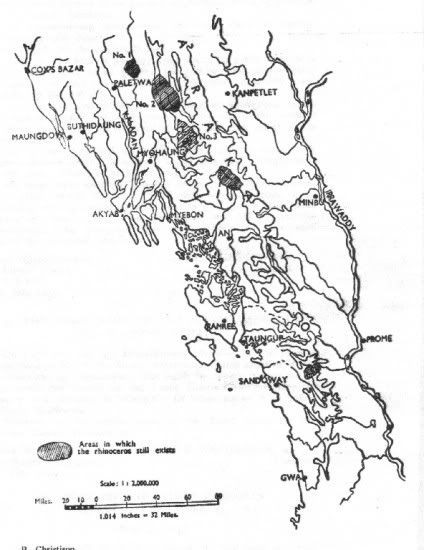 This map illustrate the Arakan Province in Myanmar, the part of the distribution from which this subspecies was first described from. Shaded areas on the maps shows were the species still was known to occur at in the mid 1940s. www.rhinoresourcecenter.com |
|
|
|
Post by sebbe67 on Nov 4, 2007 22:38:09 GMT
 Pic illustrating a male Sumatran rhino in the zoo of Yangon (Rangoon), Myanmar. It was exhibited from 1909 to about 1916. Photo from Christopher, 1916, p.228. Most likely involving a individual of this subspecies. www.rhinoresourcecenter.com |
|
|
|
Post by sebbe67 on Nov 4, 2007 22:43:38 GMT
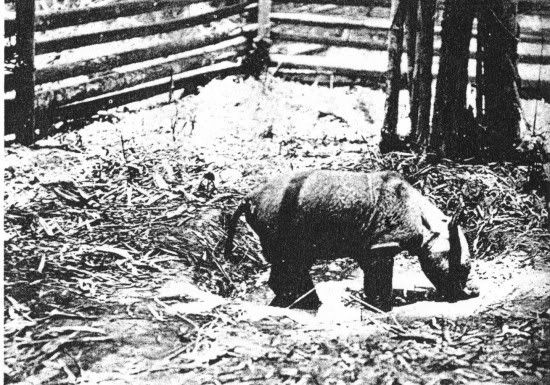 Young male Sumatran rhino captured alive in the Pegu Yomas, Myanmar in 1924. He was sent to Rangoon Zoo but died and was mounted for the American Museum of Natural History. From Vernay 1924, p.626 www.rhinoresourcecenter.com |
|
|
|
Post by sebbe67 on Nov 4, 2007 22:45:06 GMT
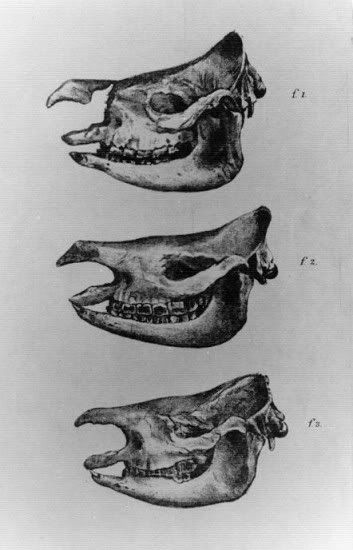 The upper and middle figure show skylls of males of Rhinoceros sumatranus, and the lower figure is a female skull. The animals were obtained in Tenasserim Province and preserved in the Museum of the Asiatic Society of Bengal in Calcutta. From Blyth 1862, pl. 3. www.rhinoresourcecenter.com |
|
|
|
Post by sebbe67 on Nov 4, 2007 22:47:39 GMT
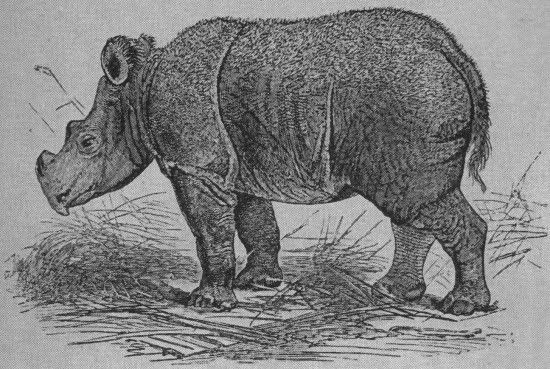 "Rhinoceros lasiotis". From the List of the vertebrated animals in the gardens of the Zoological Society of London, 9th ed., 1896, p. 139. www.rhinoresourcecenter.com |
|
|
|
Post by sebbe67 on Nov 4, 2007 22:49:11 GMT
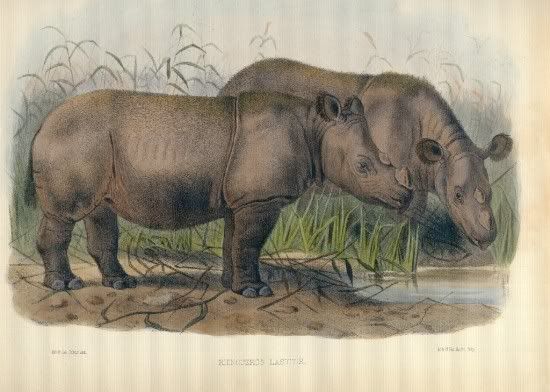 Images of the female Sumatran rhino 'Begum' shown in London Zoo from 15 February 1872 tp 31 August 1900. She was the type of Rhinoceros lasiotis. From Sclater 1876, pl. 98 www.rhinoresourcecenter.com |
|
|
|
Post by sebbe67 on Nov 4, 2007 22:52:06 GMT
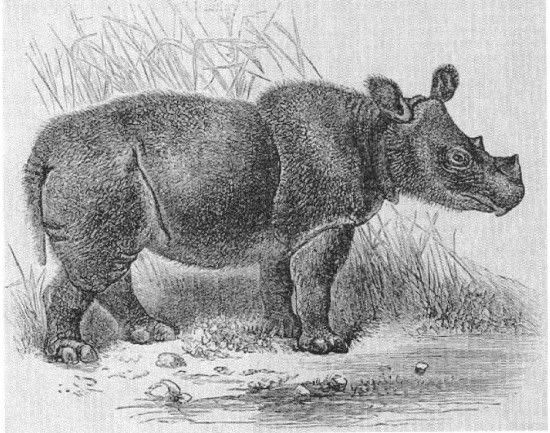 Sumatran rhinoceros female 'Begum' shown in London Zoo from 15 Feb 1872 to 31 August 1900. It was the type of Rhinoceros lasiotis. Here pictured soon after arrival. From P.L. Sclater, The new rhinoceros. Nature 6, October 24: 518. 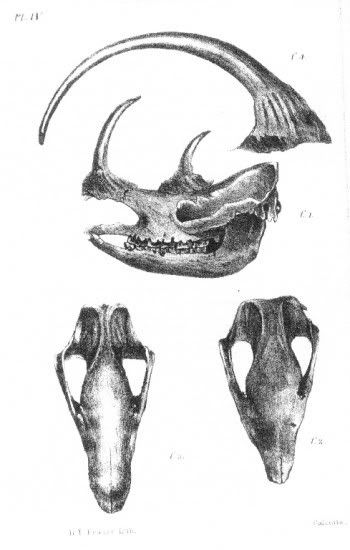 Rhino skulls in Calcutta. The complete skull in the middle was shot by Lt.Col. Fytche in Tavoy Province. The horn above it shows the type of Rhinoceros crossii in comparison. The lower figures of skulls shows specimens of Sumatran rhino. From Blyth 1862, pl. 4. www.rhinoresourcecenter.com |
|
|
|
Post by sebbe67 on Nov 10, 2007 14:05:25 GMT
|
|